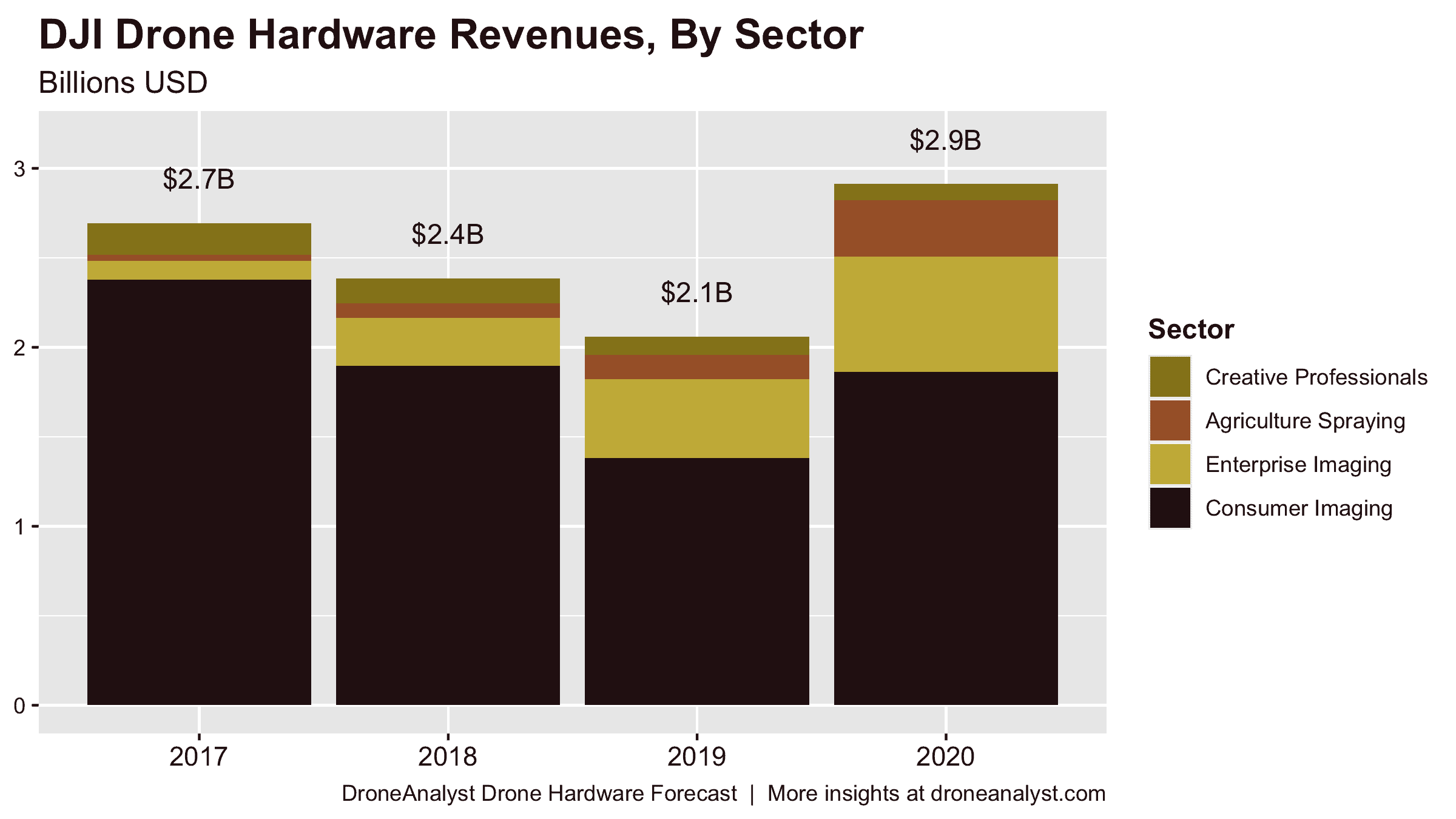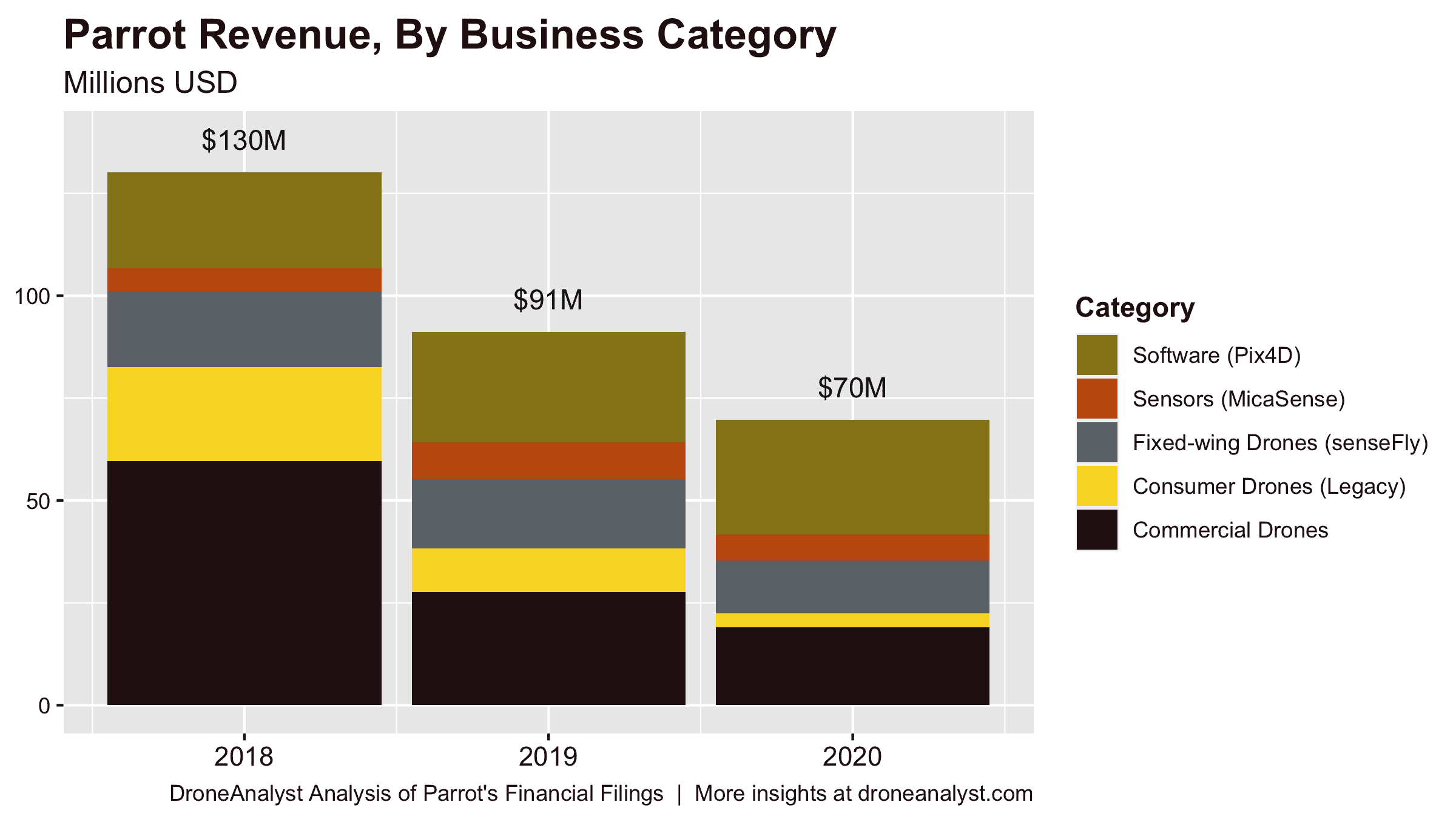New DroneAnalyst Research Dives into Market Size in Initial Hardware Sector Report
The history of the drone industry is also the history of hype and oversized forecasts. Whether that be the tale of Lily Robotics or Goldman’s $100 Billion market estimate by 2020, we’ve seen it all. And it’s understandable, drones are a new, unique piece of technology and it’s hard to predict how consumers and enterprises will adopt them. Making matters worse, there are only a small handful of public companies who publish financial data, and these firms make up just a small slice of the market.
While historically DroneAnalyst has shied away from making market estimates, with new datasets and processes, we are now confident enough to produce our own market size study, which we released in our new Drone Hardware Sector Report. This report combines DroneAnalyst’s survey data, never before used customs data, public financial data and more to provide what we believe is the most accurate (and detailed) hardware sector study to-date.
We dive into the size of the drone market, and the performance of industry leaders like DJI and Parrot below. These are just a small sliver of the data and insights available in the entire Drone Hardware Sector Report.
Sizing the Drone Market
Our analysis centres on four key market sectors – Creative Professionals, Agriculture Spraying, Enterprise Imaging and Consumer Imaging – and leaves out many other segments which are either too small, or in the early stage where forecasting growth is comparatively inaccurate. We have also left out the military segment, although we have recently detailed trends in US military spending on sUAS for anyone curious.
We found that these four sectors totalled up to $3.5 Billion in hardware sold in 2020. This was a large 46% jump over 2019 as COVID-19 saw surges in new sectors, and the consumer imaging segment recovered from a two-year decline. The full forecast is in the image below.
What is most noticeable to the English-speaking world is the large bump in Agriculture Spraying drones in 2020, which has been concentrated in Asia. What started as an interesting niche of the market, is now rising to become a market in itself. With the surge in spraying drones used to combat COVID-19 (despite doubts about their efficacy) and weakening of Chinese export restrictions, the Agriculture Spraying segment saw a massive, 135% uptick in 2020.
More broadly, we expect to see high, continued growth in the Enterprise Imaging and Agriculture Spraying sectors, while the Consumer Imaging and Creative Professional sectors slow down. Our forecast accounts for a variety of factors, including changes in regulations, technology and form factors, which will accelerate or slow down growth depending on how quickly they come into place.
Does that size seem a little low? Many will note that we had seen high revenues from firms such as DJI in the years prior. In our broader study, we explore this in much more detail, but to put it simply, what we saw in 2020 is a recovery period sped up by COVID-19. We explore this idea in more detail by diving into our estimates of DJI revenues and financial filings from Parrot below.
A Resurgent DJI, Pivoting to the Commercial Market
DJI last shared data on their revenue figures all the way back in 2017, and has since been tight lipped on their financial figures. In the mean time, we have heard news of corruption and layoffs, which tells the story of an organisation under pressure.
With our new datasets and methodology, we are happy to start filling in the gaps, and provide estimated revenues for DJI going all the way back to 2017. Additionally, we have split out DJI’s hardware revenue by market sector, accounting for consumer drones sold to enterprise users, and provided these findings in the image below. It’s important to note that our research only includes drone hardware sales, and we assume that DJI’s handheld camera products and others are driving new revenue sources for the firm.

From our data, we had seen increasingly weak sales numbers in the Consumer Imaging space until the end of 2019. At the same time, DJI’s Enterprise Imaging and Agriculture Spraying businesses have grown rapidly. Despite DJI’s overall strength and dominance in the market, they are comparatively weaker in the high growth enterprise sectors than the consumer segment – where they control 94% of the market.
Diving Into Parrot’s Financials
We can explore these larger market trends through Parrot, a long-time market player who has started to pivot their business and entire supply chain to focus on the commercial and military segments. Through this pivot they have seen the fall-off of the consumer drone segment and the rise of the competitive Blue sUAS segment, including a shift to a US-based supply chain. We’ve aggregated their quarterly financial data, converted to USD and provided a glimpse below.

We similarly see a slide in overall hardware demand from Parrot, most notably in the Consumer space (which is selling through existing stock of old units) and Commercial sector, which has been much affected by increased competition and supply chain shifts.
The Blue sUAS / dual imaging quadcopter segment their Anafi USA exists in is highly competitive (and increasingly so), with offerings from Altavian. Autel, Brinc, DJI, Teal, Skydio and Vantage. Which raises the question of why are new manufacturers focused on narrow product segments, and the overall state of hardware competition.
The State of Competition & Future of the Market
In our recent post on the industry’s reliance on DJI, we provided a table diving into which product segments DJI faces competition on. This highlights both that DJI invented many of these segments itself, and there is no competition across the majority of the industry. In fact, the product segments where DJI faces competition make up less than 20% of their sales (by units). We’ve copied over the initial table and provided it below.
| DJI Product | Segment | Price (USD) | Competition |
|---|---|---|---|
| Mini 2 | Consumer | <$500 | None |
| Mavic Air 2 | Consumer | $800 | None |
| Mavic 2 Pro/Zoom | Prosumer | <$2,000 | Strong: Autel, Skydio |
| Mavic 2 Enterprise Zoom/Dual | Enterprise | >$3,000 | Strong: Autel |
| Mavic 2 Enterprise Advanced | Enterprise | $6,500 | Strong: Altavian. Autel, Brinc, Parrot, Teal, Skydio, Vantage |
| Phantom 4 RTK | Enterprise | $6,200 | None |
| Matrice 300 RTK | Enterprise | >$13,000 | Nascent: FreeFly, Inspired Flight |
| Matrice 600 Pro | Enterprise | $5,700 | Nascent: FreeFly, Inspired Flight |
Instead, we’ve seen competitors dial-in on segments where they may have competitive advantages (country of origin) or unique hardware designs in itself (transitional VTOL, coaxial, etc). While these segments may be growth areas of the market, the large amount of competition will stifle these firms’ potential. We’ll likely see this change as the market corrects, with recent announcements of FiMi and Hubsan joining the sub 250g category, and current enterprise players adding new models.
In fact, this is a large reason why we are releasing the Drone Hardware Sector Report, to help correct mismatches in the marketplace and offer transparency to stakeholders as to which models are selling. With large, privately owned Chinese players, it can be hard to assess which segments can provide growth opportunities, and which will die off. If you’d like to learn more about the report, and it’s additional insights, you can download a sample including a Table of Contents and Methodology here.

Where to Find More Insights
- Dive into the new US Drone hardware ecosystem and trends among the US Military UAS fleet
- Understand recent regulations from the FAA on Remote Identification.
- Learn how DJI’s drone dominance was born, the consumer market faltered and may rise again.
- See how COVID-19 has increased interest in consumer drones.
- Understand the four forces that shaped the drone industry in 2020.

